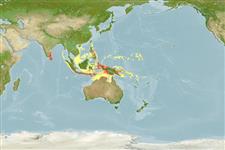Пластиножаберные (акулы и скаты) (sharks and rays) >
Carcharhiniformes (Ground sharks) >
Atelomycteridae (Coloured catsharks)
Etymology: Atelomycterus: ateles (Gr.), imperfect, unfilled or exempt; mycteros (Gr.), nostril, referring to lack of posterior nasal valve. (See ETYFish); baliensis: -ensis, Latin suffix denoting place: Bali, Indonesia, only known area of occurrence. (See ETYFish).
More on authors: White, Last & Dharmadi.
Environment: milieu / climate zone / depth range / distribution range
экология
морской демерсальный. Tropical
Western Pacific: known only from the Indonesian island of Bali.
Size / Вес / Возраст
Maturity: Lm ? range ? - ? cm
Max length : 47.4 cm TL самец/пол неопределен; (Ref. 54850)
Краткое описание
морфология | морфометрия
A relatively small (max. size 474 mm TL) Atelomycterus with the following combination of characters: relatively short preoral length, 4.0-4.6% T; short interdorsal space, 11.6-12.9% TL; high pectoral-pelvic to pelvic-anal ratio 1.28-1.48; dorsal fins weakly falcate, with posterior margins vertical or sloping anteroventrally from fin apices; prebranchial denticles strongly tricuspid with narrow, elongate medial cusps; claspers of adults short, not stubby, not tapering sharply distally, outer length 8.3-9% TL, base width 5.4-6.3% of outer length; clasper glans covering more than half of clasper; cover rhipidion relatively narrow; rhipidion large, relatively low, and only partly concealed by cover rhipidion and exorhipidion; exorhipidion small with proximal end well behind distal end of cover rhipidion; total vertebral centra 154-163, precaudal centra 101-106; dorsal surface with well-defined dark saddles consisting mainly of four, partly coalesced, diffuse-edged, dark brown blotches; white partly coalesced, diffuse-edged, dark brown blotches; white spots absent from body and rarely on fins; inner margin of pale tips of dorsal fins orientated almost vertically; upper pectoral fin lacking a broad, sharply defined whitish margin.
Biology unknown; presumably reef-dwelling, inhabiting holes and crevices on reefs, like other related catsharks. Presumably oviparous. Diet probably dominated by small invertebrates . Caught irregularly by fisheries operating over coral reefs. Utilized for its meat but of limited value (Ref.58048).
Life cycle and mating behavior
половая зрелость | размножение | нерест | икра | Fecundity | личинки
White, W.T., P.R. Last and Dharmadi, 2005. Description of a new species of catshark, Atelomycterus baliensis (Carcharhiniformes: Scyliorhinidae) from eastern Indonesia. Cybium 29(1):33-40. (Ref. 54850)
Статус Красного Списка МСОП (Ref. 130435)
Угроза для людей
Harmless
Использование человеком
дополнительная информация
народные названиясинонимыобмен веществхищникиэкотоксикологияразмножениеполовая зрелостьнерестSpawning aggregationFecundityикраРазвитие икры
Возраст/РазмерыростЗависимость между длиной и массой телаЗависимость между длинамиРазмерный составморфометрияморфологияличинкидинамика численности личинокпополнениечисленностьBRUVS
ссылкиаквакультура (рыбоводство)особенности рыбоводствастепень растяжениягенетикаElectrophoresesнаследуемостьболезниобработкаNutrientsMass conversion
соавторыизображенияStamps, Coins Misc.звукиCiguateraскоростьтип плаванияжаберная областьOtolithsмозгзрение
инструменты
Специальные отчеты
Скачать в формате XML
ресурсы в Интернет
Estimates based on models
Phylogenetic diversity index (Ref.
82804): PD
50 = 0.5156 [Uniqueness, from 0.5 = low to 2.0 = high].
Trophic level (Ref.
69278): 3.7 ±0.3 se; based on size and trophs of closest relatives
устойчивость к внешним воздействиям (Ref.
120179): низкий, минимальное время удвоения популяции 4.5-14 лет (Low fecundity (RF)).
Fishing Vulnerability (Ref.
59153): Moderate vulnerability (37 of 100).
